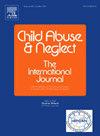Placement, duration and re-entry outcomes for children in foster care with disabilities
IF 3.4
2区 心理学
Q1 FAMILY STUDIES
引用次数: 0
Abstract
Background and objectives
National, longitudinal studies exploring characteristics and outcomes of children in foster care (CFC) with disabilities are lacking. This study explores the prevalence, characteristics and relative risk of experiencing placement instability, staying in care for longer than 2 years, and returning to care within 3 years for CFC with a disability and by disability type.
Participants and setting
2.9 million unique participants within the U.S. Adoption and Foster Care Analysis and Reporting System (AFCARS) data who first entered care FY2005-FY2018.
Methods
We created a longitudinal cohort using AFCARS data. Characteristics and outcomes were compared between children with and without disability and by disability types (emotional, intellectual, hearing/vision, physical, other).
Results
CFC with all disability types, except physical, had higher risk of placement instability than those without disability, with CFC with emotional disability having the highest risk (RR: 2.86, 95 % CI: 2.82–2.91). CFC with each disability type had a higher risk of remaining in care for more than 2 years, with CFC with intellectual and visual/hearing disability having the highest relative risk (RR: 1.44, 95 % CI: 1.40–1.47 and RR: 1.39, 95 % CI: 1.36–1.41, respectively). After first exit from care, children with emotional disability had higher risk of returning to care within 3 years (RR: 1.24, 95 % CI: 1.22, 1.26).
Conclusions
Findings suggest that greater effort is needed from the child welfare and healthcare systems to recognize and address the health-related needs of this population, particularly CFC with an emotional disability, and to support their caregivers.
残疾寄养儿童的安置、持续时间和重返社会的结果
背景与目的目前缺乏针对残疾寄养儿童(CFC)特征和结果的全国性、纵向研究。本研究探讨了残疾CFC患者的患病率、特点和经历安置不稳定、住院时间超过2年以及在3年内重返护理的相对风险。参与者和设置在美国收养和寄养分析和报告系统(AFCARS)数据中首次进入护理的290万独特参与者2005- 2018财年。方法采用AFCARS数据建立纵向队列。比较残疾儿童和非残疾儿童的特征和结果,并按残疾类型(情感、智力、听觉/视觉、身体、其他)进行比较。结果除身体残疾外,所有残疾类型的儿童安置不稳定风险均高于无残疾的儿童,其中情绪残疾的儿童安置不稳定风险最高(RR: 2.86, 95% CI: 2.82 ~ 2.91)。每种残疾类型的CFC患者留在护理超过2年的风险较高,其中智力和视觉/听力残疾的CFC患者的相对风险最高(RR: 1.44, 95% CI: 1.40-1.47, RR: 1.39, 95% CI: 1.36-1.41)。首次退出护理后,情绪障碍儿童在3年内重返护理的风险较高(RR: 1.24, 95% CI: 1.22, 1.26)。结论:研究结果表明,儿童福利和卫生保健系统需要做出更大的努力,以认识和解决这一人群的健康相关需求,特别是有情感残疾的CFC,并支持他们的照顾者。
本文章由计算机程序翻译,如有差异,请以英文原文为准。
求助全文
约1分钟内获得全文
求助全文
来源期刊

Child Abuse & Neglect
Multiple-
CiteScore
7.40
自引率
10.40%
发文量
397
期刊介绍:
Official Publication of the International Society for Prevention of Child Abuse and Neglect. Child Abuse & Neglect The International Journal, provides an international, multidisciplinary forum on all aspects of child abuse and neglect, with special emphasis on prevention and treatment; the scope extends further to all those aspects of life which either favor or hinder child development. While contributions will primarily be from the fields of psychology, psychiatry, social work, medicine, nursing, law enforcement, legislature, education, and anthropology, the Journal encourages the concerned lay individual and child-oriented advocate organizations to contribute.
 求助内容:
求助内容: 应助结果提醒方式:
应助结果提醒方式:


